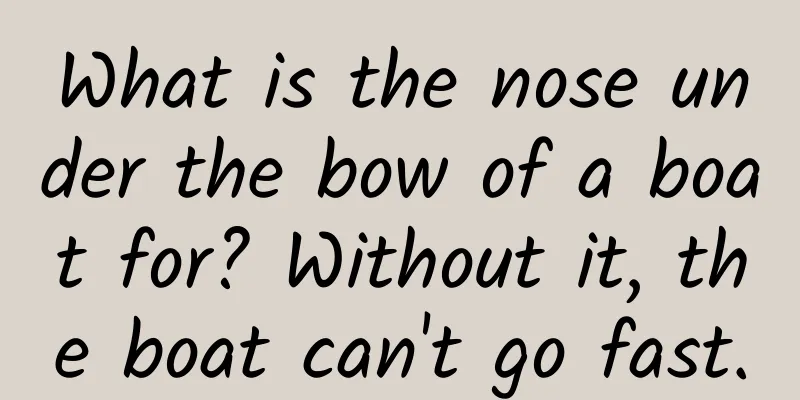What is the nose under the bow of a boat for? Without it, the boat can't go fast.

|
Have you ever noticed those ocean-going cargo ships sailing against the wind and waves? There is an obvious spherical protrusion under the bow. It looks like the bow has a nose, which is very inconsistent with the overall shape of the ship. What is this thing used for? This thing is called "ship nose bow", also called "ship bulb bow". Although it doesn't look good, don't underestimate it, because without it, the ship can't run fast. In history, the maximum speed of ocean-going cargo ships has reached 33 knots, and now the sailing speed of ocean-going cargo ships is mostly around 20 knots. What is the concept of 20 knots? It is roughly equivalent to 37 kilometers per hour. This speed is really not slow, because under normal circumstances, the speed of cars driving on the street will not exceed 40 kilometers per hour, and even on the national highway, there is a speed limit of 80 kilometers per hour. The speed of a car on the highway is 80 kilometers per hour, while the speed of an ocean-going freighter is 37 kilometers per hour, which is less than half of the speed of a car. But don’t forget that the ship is sailing in the water, and the resistance of water is about 800 times that of the resistance in the air. In this light, don’t you think the speed of the ship is amazing? So why can ships reach such high speeds? At least half of the credit should be attributed to the "bow", which is the spherical protrusion under the bow. So how does the bow increase the speed of the ship? Let's first look at where the resistance of the ship mainly comes from during sailing. When the ship is sailing forward, it is blocked by the sea water in front, so the sea water at the bow will be pushed up by the ship, and then the pushed up sea water will flow along the hull to the sides of the hull and form undulating waves on the side of the ship. The resistance a ship encounters when sailing is closely related to one factor, that is, the contact area between the sea water and the ship. The undulating waves will inevitably increase the contact area, thereby increasing the resistance encountered by the ship and affecting the ship's sailing speed. This resistance is called "wave-making resistance." We can also think about how wave resistance reduces the speed of ships from an essential point of view. Movement requires energy. Before the arrival of the ship, the sea is calm and the waves are caused entirely by the ship. Therefore, the energy of the waves is essentially provided by the ship. These waves actually consume part of the power of the ship. To reduce the power loss, we must try to eliminate these waves, and thus the "ship nose bow" was born. After installing the bow, the wave fluctuations on both sides of the hull are significantly reduced, and the speed of the ship is also significantly improved. According to past experience, the maximum speed of the same ship with and without the bow installed can differ by 5-10 knots. The role of the bow is unquestionable, so how does the bow eliminate waves? This can be divided into two aspects. One is the shape of the bow itself. The bow is a spherical object. We can do an experiment. Use a rope to pull a small ball to move in a basin of water, and then use a rope to pull a small cube to move in a basin of water. You will find that the waves generated by the small ball are significantly smaller than those of the cube. Why is this? Because in front of the spherical object, the water will bulge due to pressure, but when the bulging water comes to the back of the small ball, the pressure will drop instantly, and the bulging water surface will quickly fall back, so that the waves will naturally be smaller. The second reason is that the bow of the ship will form a wave that flips 180°, which will cancel out the original wave. When a ship sails forward, waves will form on both sides of the hull. The waves generated by the bow are just opposite to the waves formed by other parts. So what effect will the superposition of two opposite waves produce? Naturally, they will cancel each other out, so the originally ups and downs of the waves become calm. Using the superposition effect of waves to eliminate waves has a wide range of applications in life, such as sound waves. Using opposite sound waves to eliminate the original sound waves is the basic principle of noise-canceling headphones. Now there is a new question, that is, how does the bow of the ship produce a wave that flips 180°? The size of the waves generated by a ship during its travel is closely related to the ship's sailing speed. The waves generated by different sailing speeds are extremely different. Therefore, if you want the bow to work, there must be a "design speed". The bow cannot guarantee that it will produce waves that flip exactly 180° at any time. It can only work at the design speed. If the ship's sailing speed deviates from the design speed, the resistance reduction effect of the bow will be greatly reduced. It may even produce waves that are exactly the same as the original waves at certain times. This will produce larger waves when superimposed, which will increase the ship's sailing resistance. In addition, different ships have different requirements for the shape of the bow. The most common ones are the ram-type bow and the teardrop-shaped bow. The former is often used in ocean-going cargo ships, and the latter is mostly used in high-speed ships. For more information, please follow the official account: sunmonarch |
<<: If an owl lives in a cave and likes to poop...
>>: Why is gold, a precious metal, so valuable? | Science Gallery
Recommend
Refrigerator ≠ safe, take a look at who the “dangerous elements” are in the refrigerator!
The tragedy that occurred in October 2020 in Jixi...
Programmers: The age of 30 that cannot be hurt
[[120972]] Programmers work until they are 30, an...
Where should I place the router for the best Wi-Fi signal?
The antenna in the wireless router will emit elec...
Mr. Huang's exclusive career tips: job hunting
Course Catalog: ├──【Job Hunting Class·Must Listen...
How many steps are there to distinguish between "aviation" and "aerospace"?
Review expert: Qian Hang, aerospace science exper...
Joining the smart hardware battlefield, what attracts PPTV mobile phones
More and more Internet companies are joining the ...
What happened to the mystery of room-temperature superconductivity in those years?
Recently, South Korea's room-temperature supe...
How to promote user sharing and dissemination?
For internet dogs, it is easy to organize an even...
If you encounter them, don't pick them randomly, it will be very "punishing" (Part 1)
Beijing is One of the most biodiverse metropolita...
Case study: How to make information flow advertising in the beauty industry more effective?
Women love beauty, forever Regarding why women lo...
Dalian stops group dining in catering units (with original text)
Dalian: Suspension of collective dining activitie...
How much does it cost to develop a luggage mini app in Jiaozuo?
How much is the quotation for Jiaozuo luggage dev...
How to do offline community marketing?
With the vigorous development of China's soci...
Cognition and scale—how do operations intervene in products?
Products and operations may indeed conflict over ...







![Maya hard surface imitation racing motorcycle production process [HD quality]](/upload/images/67cc12b4eb5cc.webp)

